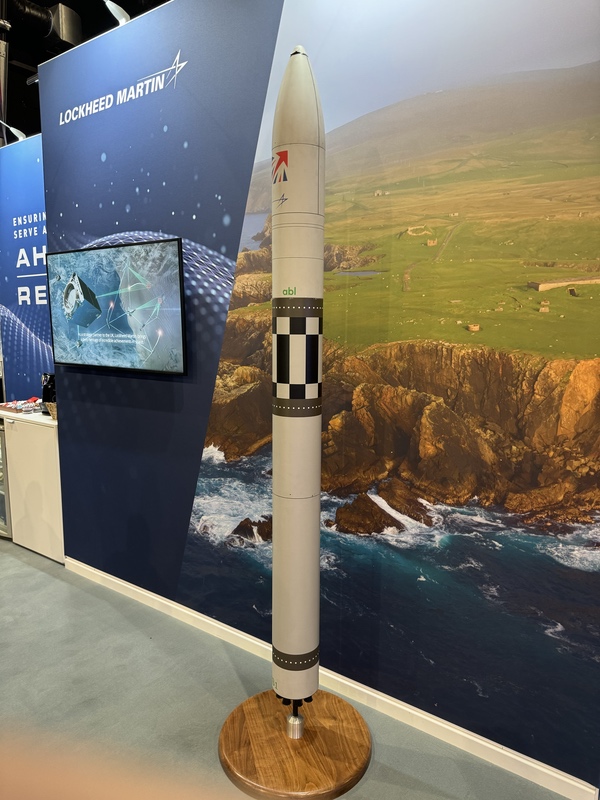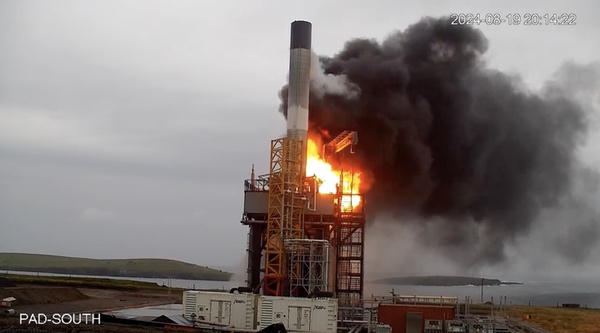Still waiting for liftoff in the UKby Jeff Foust
|
| “If anybody tells you in this industry when a launch is going to be,” Hammond said, “they’re lying to you because there are a lot of speed bumps.” |
The model was a representation of a planned launch of a “UK Pathfinder” mission by Lockheed for the agency using the RS1. At Farnborough six years earlier, the UK government announced a contract to Lockheed to conduct a launch from a spaceport in the country as part of the government’s initiative to foster a domestic launch capability. Lockheed later selected ABL, a launch startup that Lockheed had both awarded contracts to and invested in, to carry out the mission, which after many delays was projected for 2025.
The timing of the display, though, was unfortunate. On the first day of the air show, ABL announced that its second RS1 rocket had suffered “irrecoverable damage” in a fire on its launch pad in Alaska during tests ahead of a launch there.
ABL, in a statement about a month later, said that fuel leaking from engines fed a fire that broke out under the vehicle during an aborted static-fire test. The pad at the Pacific Spaceport Complex – Alaska on Kodiak Island did not have its own water supply, and water tanks there ran out without extinguishing the fire. The flames, now unchecked, destroyed the rocket.
The incident was the latest setback in the UK effort to become a launching state. Since the rollout of the initiative at Farnborough in 2018, which included funding to both Lockheed Martin and startup Orbex and selection of a site in northern Scotland for a spaceport (see “British launch plans finally lift off”, The Space Review, July 23, 2018), the effort suffered problems ranging from vehicle development delays to launch and business failures.
By 2024, the planned UK Pathfinder launch was no longer expected to be a pathfinder. It would not be the first orbital launch attempt from the country: in January 2023, Virgin Orbit conducted a mission of its LauncherOne air-launch system from Spaceport Cornwall in southwestern England. That launch, though, failed to reach orbit, and three months later Virgin Orbit filed for bankruptcy, to be liquidated soon thereafter.
It was also no longer expected to be the first vertical launch from the UK. At Farnborough, the focus was on German company Rocket Factory Augsburg (RFA), whose RFA ONE rocket was undergoing final testing at SaxaVord Spaceport in the Shetland Islands.
“Everything is gearing up very much for the next steps in our journey to space,” declared Scott Hammond, deputy chief executive and operations director of SaxaVord Spaceport, during a presentation at Farnborough. RFA had already performed some static-fire tests of the rocket’s first stage at the spaceport and, he said, would soon resume them, this time with all nine of the engines in the stage.
If all went well, he suggested, the inaugural RFA ONE launch could take place as soon as September, although he offered some caution. “If anybody tells you in this industry when a launch is going to be,” he said, “they’re lying to you because there are a lot of speed bumps.”
The spaceport, and RFA, hit a major speed bump weeks later. In a static-fire test at the pad August 19, a fire broke out on the pad as one of the nine Helix engines appeared to explode. The entire stage itself was soon destroyed.
In a statement several days later, Stefan Brieschenk, co-founder and chief operating officer of RFA, said that a fire likely broke out in an oxygen pump in one engine, a “very unusual” failure mode not seen in previous engine tests that vehicle and pad systems were not designed to contain. “It appears that everything that followed thereafter was simply not sized for this extensive damage from this oxygen fire in the turbopump,” he concluded.
“We wanted to launch within the next few weeks and months,” he said, but that schedule is on indefinite hold as it investigates the failure and builds a new first stage. He added that the launch pad infrastructure largely escaped damage.
Orbex has still not gotten to the launch pad—or completed that launch pad. The company is making progress on Sutherland Spaceport, the northern Scotland site picked by the UK government in 2018. “We expect the spaceport to be ready in early spring of next year,” Phil Chambers, CEO of Orbex, said at Farnborough.
| “The key thing for that first mission was always going to be exercising, stress testing, our ability to license, and Virgin Orbit definitely did a lot of stress-testing of that process,” Archer said. |
The company had not offered many public updates about its progress on its Prime small launch vehicle in recent months but had gone through a series of executive changes since last year. Chambers, who took over as CEO early this year, said he expected that the company to be ready for a first launch attempt some time next year, but did not a more specific date other than a desire to avoid poor weather conditions in the winter there. “But I do want it to be 2025,” he added.
He said the company is planning to raise another round of funding for a factory that will allow it to scale up production of Prime. “We can probably handmake about three or four a year” with its current facilities, he said; a new one would allow production to grow to 24 per year.
It’s unclear if there is demand for 24 launches a year of Prime, a vehicle capable of placing up to 180 kilograms in orbit. Rocket Lab’s Electron, in a similar performance class, has done ten launches so far this year (an eleventh is scheduled for this week) and the company has said issues with customers have prevented it from doing more.
 A model of ABL’s RS1 rocket, in livery for the UK Pathfinder launch, on display at the Farnborough International Airshow in July. (credit: J. Foust) |
Several factors have played a role in the struggles that the UK has seen trying to develop a launch industry. “Covid threw a spanner in everyone’s works,” said Matthew Archer, director of launch at the UK Space Agency, in an interview at Farnborough. “For most of our companies, they lost 18 months to two years in their overall production schedule, mostly because of Covid.”
Companies have also struggled to raise money, which he said is linked to a broader contraction in space industry investment in the last couple of years as interest rates rose; at the same time, space insurers suffered major losses that made it harder for companies to secure coverage.
However, there has been progress in other areas, like launch regulations that Virgin Orbit was able to successfully navigate to win approval for its launch. “The key thing for that first mission was always going to be exercising, stress testing, our ability to license, and Virgin Orbit definitely did a lot of stress-testing of that process,” Archer said.
Commercial launches are regulated in the UK by the Civil Aviation Authority (CAA). “Virgin Orbit’s mission didn’t do what it hoped it would do, but for us it assured that entire system does work from end to end,” said Colin Macleod, head of UK space regulation at the CAA. He added that four companies have “plausible ambitions” to launch from the UK in the next 18 months.
Archer said that, in hindsight, he might have taken a different approach to supporting launch from the UK. “We deliberately picked a range of spaceports and providers on the basis that we knew that not all of them would succeed,” he said. “I would probably targeted more on specific spaceports” like SaxaVord and Sutherland. “We might have done more to de-risk some of those programs.”
| “Sometimes I worry that the politicians want to see success straight away and, if not, they lose interest,” Hammond warned. |
It's unclear how much additional support the UK government might provide for launch. The air show took place just weeks after the Labour party won parliamentary elections. While industry officials were gratified that Peter Kyle, the new minister whose portfolio includes space, made his first speech since taking the post at Farnborough, the government has offered few details about how it might approach space issues.
SaxaVord’s Hammond said he was concerned in general that launch failures might cause a loss of support. “This is a test flight, and it is an iterative process: we learn as we go along,” he said, setting expectations for the expected first flight of RFA ONE. “Sometimes I worry that the politicians want to see success straight away and, if not, they lose interest.”
RFA plans to return to SaxaVord and make another launch attempt, some time next year. The future is less certain for ABL and the UK Pathfinder launch: in late August, ABL announced it was laying off an unspecified number of employees as part of efforts to cut costs. The company had already been working to trim its costs without layoffs, wrote CEO Harry O’Hanley in an email to employees. “Through these efforts, we were able to get onto a good glidepath, but the recent staticfire issue knocked us from it.”
That announcement gave few details about the schedule for RS1, though. The reorganization and layoffs would “reset the cost structure of the business to be sustainable in any environment,” he wrote, including one that has turned far less hospitable than what companies and agencies on both side the Atlantic expected six years ago.
Note: we are now moderating comments. There will be a delay in posting comments and no guarantee that all submitted comments will be posted.
